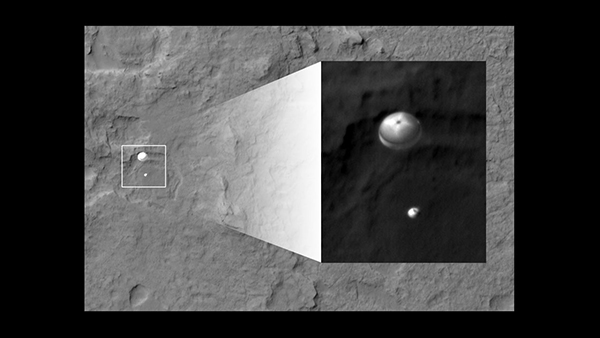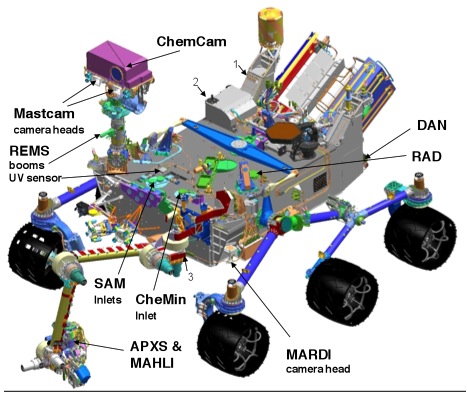
by Timothy Oleson Monday, August 6, 2012

NASA's Curiosity rover, also known as the Mars Science Laboratory, touched down on the red planet's surface early Monday morning August 6 EDT. NASA

This image of Curiosity, with its parachute deployed, was taken as it descended through the Martian atmosphere by the High-Resolution Imaging Science Experiment (HiRISE) camera aboard the Mars Reconaissance Orbiter. NASA

An illustration of Curiosity's scientific instrumentation, including the Sample Analysis at Mars (SAM) unit. NASA
This has been a year of scientific milestones. In just the last few months, we have witnessed the first successful launch of a privately built spacecraft — SpaceX’s Dragon capsule — which docked with the International Space Station in May, as well as the announcement in July that the Higgs Boson, the lynchpin particle in the Standard Model of physics, had at last been confidently detected. And by now, you have surely heard that Curiosity — the latest model in NASA’s lineage of robotic Mars-exploring rovers — has successfully landed on the red planet. In case you hadn’t, here is your official notice:
CURIOSITY HAS LANDED ON MARS!
Confirmation of the rover’s safe descent brought sheer delight — along with a heavy dose of relief — to all those science enthusiasts who have followed its development (including here at EARTH), but most especially to the many scientists, engineers and administrators who have had a hand in its creation. You need not look very hard to find exultations from NASA officials and Curiosity team members expressing the momentous nature of the accomplishment.
With each mission to Mars, and particularly when it comes to the rovers, the imagination and ingenuity that goes into designing landing mechanisms seems multiplied. Whereas its predecessors, including Sojourner in 1997 and Spirit and Opportunity in 2004, bounced and rolled their way to safety courtesy of a protective shell of inflated airbags, Curiosity was lowered by an elaborate sky crane that used retrorockets to hover less than 10 meters above the ground. But this was the just the final step in an intricate, fully pre-programmed sequence (video).
After hurtling through space at more than 20,000 kilometers per hour, the spacecraft initially slowed due to the friction of Mars’ atmosphere. Still traveling at about 3,000 kilometers per hour, a parachute — capable of withstanding extraordinary drag — deployed 12 kilometers above Mars’ surface to continue slowing the capsule. About eight kilometers above the surface, the capsule’s heat shield was shed and an internal radar navigation system, which detected altitude and velocity, took over automated control of the descent. Eighty seconds later and with less than two kilometers to go, the sky crane, holding Curiosity in its grasp, jettisoned its parachute and fired retrorockets to slow itself from 280 kilometers per hour to a near standstill just meters above the surface. Finally, after lowering Curiosity via cables, the crane fired its rockets and was safely ejected away from the landing site.
Despite its complexity, the innovative sequence was considered “the least crazy option" for landing Curiosity on Mars by its designers. The bouncing beach ball technique that was used for Sojourner, about the size of radio-controlled truck, and the go-kart-sized twins, Spirit and Opportunity, was out of the question because of Curiosity’s relatively large size: At about 900 kilograms (at least on Earth), car-sized Curiosity is five times heavier than Spirit and Opportunity.
Curiosity’s intact delivery to the Martian surface is awe-inspiring to be sure. But with the spectacular landing behind us, perhaps what we should be more excited about is what we have to look forward to from our newest interplanetary colonist. As its technical name, the Mars Science Laboratory (MSL), implies, Curiosity’s real purpose is not simply to prove that we can send ever-larger rovers to Mars.
“We have ended one phase of the mission, much to our enjoyment … but another part has just begun. And really, it’s the fundamental reason we built the rover,” said mission systems engineer Mike Watkins at a press conference on Monday.
The next part of the mission to which Watkins referred is Curiosity’s science mission, which is far more expansive than that of any of the six previous landers to reach Mars’ surface. Sojourner was a proof-of-concept for later rovers; Spirit and Opportunity were sent to study the basics of Mars’ geology; and in 2008 Phoenix landed in search of water. Now, MSL’s primary goal is no less than to search for signs of once-habitable environments and past life on Mars.
These signs include evidence that appreciable quantities of water once flowed on Mars’ surface. Specific minerals, rocks and geologic features that form in the presence of liquid water — a necessity for life as we know it — would provide clues necessary to delineate if, when, where and over what duration such water once existed. Beyond water, MSL is designed to sample Mars’ soil and rocks and analyze them for other nutrients and elements necessary to support life. Most importantly, this means searching for organic carbon — the fundamental building block for life — which no prior mission has been equipped to do.
To help with its diverse array of sampling and analytical tasks, MSL is stuffed with a multitude of instruments and sensors custom-designed to be as compact as possible and to withstand Mars’ harsh working conditions. (Although five times heavier than Spirit and Opportunity, Curiosity is only about twice their size.) To give just a few examples, Curiosity carries 17 separate cameras, a 2.1-meter sampling “arm” with a laser-equipped spectrometer, temperature and weather sensors, atmospheric and radiation detectors, an X-ray spectrometer and a plutonium-powered battery intended to keep everything running for at least two years.
A gas chromatograph, mass spectrometer and yet another laser spectrometer also combine to form the Sample Analysis at Mars (SAM) unit, which will ultimately look for carbon in both simple forms such as methane and as more complex molecular fossils — the remains of biological molecules left behind by cellular life such as microbes. (I recall being amazed by this particular piece of equipment while attending a presentation as a graduate student about the SAM’s development. Whereas an equivalent collection of instruments would typically require an entire laboratory here on Earth, the SAM fits comfortably on a tabletop.)
With its scientific arsenal intact on Mars’ surface, the long wait for Curiosity’s main mission to begin is finally over. Finding evidence of past life would, of course, be monumental, giving us new insights about the boundaries within which life can exist and about our own origins on Earth. Regardless of what the rover finds, however, it is poised to begin providing the most detailed information we’ve ever received about Mars.
There will surely be more ambitious missions to come. But for now, and likely for the rest of this decade at least, this one holds the title. Perhaps it’s time to stop referring to our inspirational scientific achievements as “Sputnik moments” and start referring to them as moments of Curiosity.
© 2008-2021. All rights reserved. Any copying, redistribution or retransmission of any of the contents of this service without the expressed written permission of the American Geosciences Institute is expressly prohibited. Click here for all copyright requests.